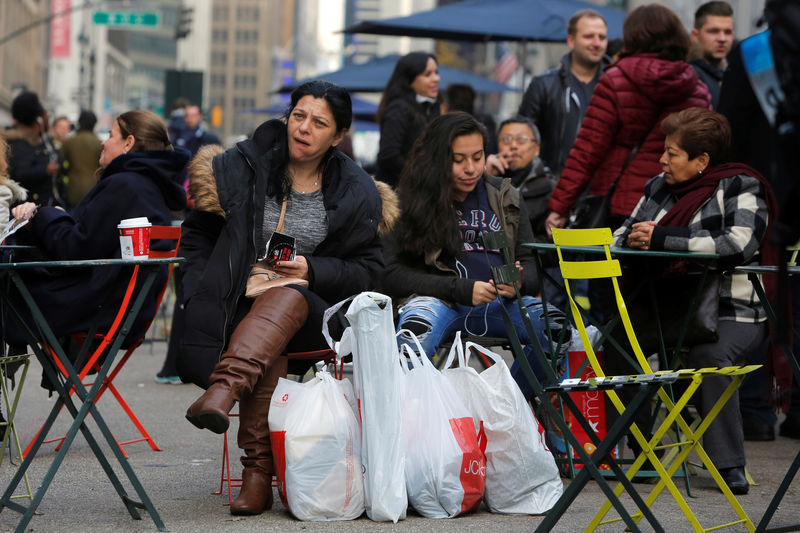By Lucia Mutikani
WASHINGTON (Reuters) - U.S. retail sales barely rose in November and industrial production recorded its biggest drop in eight months, suggesting some loss of momentum in economic growth in the fourth quarter.
The weak retail sales and industrial output readings reported on Wednesday did not deter the Federal Reserve from raising interest rates 25 basis points to between 0.50 percent and 0.75 percent. The Fed signaled a faster pace of increases in 2017, against the backdrop of steadily rising inflation and a tightening labor market.
Other data showed producer prices notching their largest increase in five months in November amid a jump in the cost of services. The moderation in retail sales came after two straight months of strong gains. With incomes rising, household wealth at record highs and robust consumer sentiment, the cool-off in retail sales is likely to be temporary.
"Consumer spending remains the main engine of growth for the economy," said Harm Bandholz, chief U.S. economist at UniCredit Research in New York. "Solid employment growth and accelerating wage gains will continue to support household spending. This dynamic allowed the Fed to raise rates today and gave them confidence to signal further rate hikes next year."
Retail sales edged up 0.1 percent last month as households cut back on motor vehicle purchases after rising 0.6 percent in October, the Commerce Department said. Sales were up 3.8 percent from a year ago. Excluding automobiles, gasoline, building materials and food services, retail sales also nudged up 0.1 percent last month after gaining 0.6 percent in October.
These so-called core retail sales correspond most closely with the consumer spending component of gross domestic
product. Economists had forecast overall retail sales increasing 0.3 percent and core sales also gaining 0.3 percent last month.
In another report, the Fed said industrial production
fell 0.4 percent last month, pulled down by a 4.4 percent drop in utilities output as warmer-than-normal temperatures cut demand for heating. The drop in industrial production was the largest since March.
Manufacturing production slipped 0.1 percent, held back by a 2.3 percent drop in motor vehicle output. Excluding autos, manufacturing output rose 0.2 percent. Mining production surged 1.1 percent amid rising oil and gas well drilling as the drag from last year's collapse in oil prices fades.
Nevertheless, the soft retail sales and industrial production, together with a another report from the Commerce Department showing business inventories recording their biggest drop in 11 months in October, implied the economy was slowing in the fourth quarter after growing at a brisk 3.2 percent annualized rate in the July-September period.
The Atlanta Fed trimmed its fourth-quarter GDP growth estimate by two-tenths of a percentage to a 2.4 percent rate after the data.
The dollar reversed losses against a basket of currencies, rallying to a near 14-year high after the Fed suggested it would raise borrowing costs three times next year.
Prices for U.S. government bonds fell, with yields on two-year Treasury (US2YT=RR) notes rising to their highest level since August 2009. Stocks on Wall Street ended lower.
The U.S. central bank hiked its overnight benchmark interest rate last December for the first time in nearly a decade.
The Fed's anticipated faster pace of rate increases in 2017, is likely in response to president-elect Donald Trump's planned expansionary fiscal policy agenda aimed at boosting growth through infrastructure spending and tax cuts.
INFLATION PERKING UP
A third report from the Labor Department showed its producer price index for final demand increased 0.4 percent last month, the largest gain since June, after being unchanged in October.
In the 12 months through November, the PPI rose 1.3 percent, the biggest gain in two years. The PPI rose 0.8 percent in the 12 months through October.
A 0.5 percent increase in the cost of services accounted for more than 80 percent of the rise in the final demand PPI last month. The increase, which followed a 0.3 percent decline in October, was the largest since January.
With producer prices pushing higher, overall inflation is expected to steadily move toward the Fed's 2 percent target.
"The prospects of strengthening demand point to upward inflation pressures in 2017," said Sam Bullard, a senior economist at Wells Fargo (NYSE:WFC) Securities in Charlotte, North Carolina.
Last month's weak retail sales figures came despite consumer confidence rising to cycle highs, leaving some economists to expect that the numbers would revised higher when the government releases December's report in January.
Sales at clothing stores were flat last month. Department stores like Macy's (N:M) and Kohl's (N:KSS) are facing intense competition from online retailers such as Amazon (O:AMZN), which have snatched a large chunk of the market share.
But online retail sales rose marginally last month. There were solid gains in sales at furniture, food and beverage, as well as building material stores. Americans also spent more at restaurants and bars last month.

"We are a bit skeptical of this morning's numbers," said Michelle Girard, chief economist at NatWest Markets in Stamford, Connecticut. "Given anecdotal evidence and the rise in consumer confidence, we suspect the November figures could get revised higher or will be followed by a much improved performance."